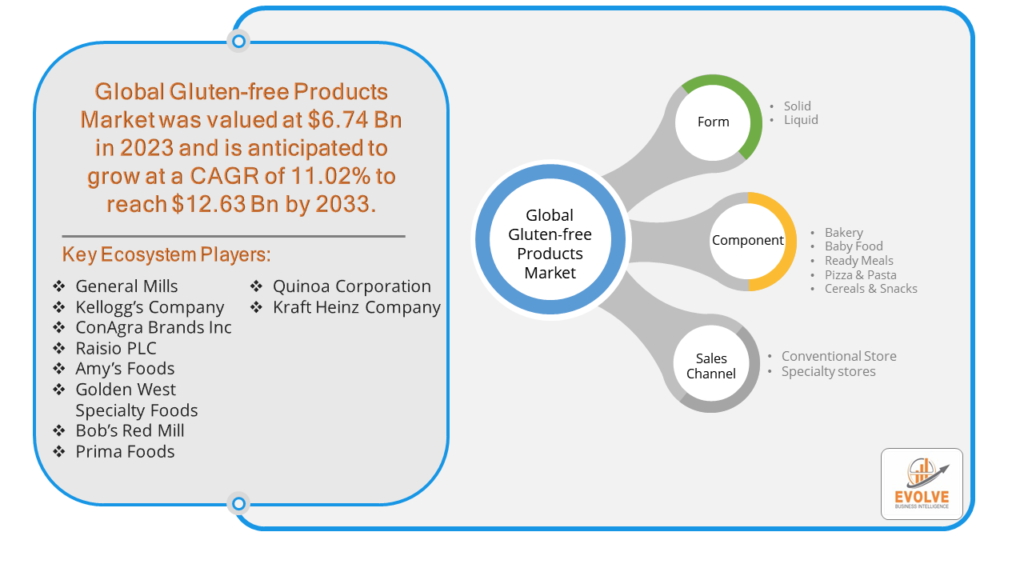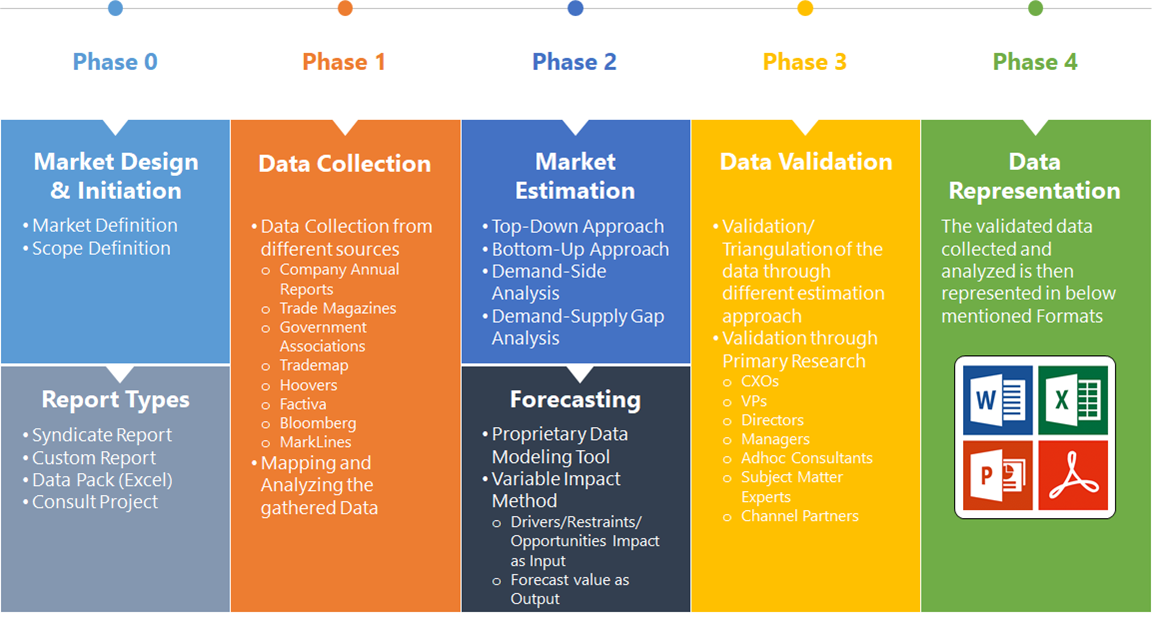Gluten-free Products Market Analysis Overview
The Gluten-free Products Market Analysis Size is expected to reach USD 12.63 Billion by 2033. The Gluten-free Products Market Analysis industry size accounted for USD 6.74 Billion in 2023 and is expected to expand at a compound annual growth rate (CAGR) of 6.47% from 2023 to 2033. A gluten-free products market analysis examines the current state and future prospects of the market for products that don’t contain gluten. This involves estimating the total revenue generated by the sale of gluten-free products and how fast that revenue is increasing.
This identifies the major players in the market, their market share, and their product offerings. It also examines trends like mergers and acquisitions, new product launches, and marketing strategies. By analyzing these factors, a gluten-free products market analysis can help businesses understand the potential of this market, identify new opportunities, and make informed decisions about product development, marketing, and investment.
Global Gluten-free Products Market Analysis Synopsis
The COVID-19 pandemic had a significant impact on the gluten-free products market. The pandemic heightened awareness about health and wellness, leading more consumers to adopt gluten-free diets as part of a broader focus on healthy eating. During the early stages of the pandemic, many consumers stockpiled food items, including gluten-free products, leading to temporary spikes in sales. Lockdowns and stay-at-home orders resulted in a surge in home cooking and baking, increasing demand for gluten-free ingredients and mixes. COVID-19 led to temporary shutdowns and reduced operations at manufacturing facilities, causing disruptions in the production of gluten-free products. With physical stores facing restrictions or closures, there was a significant shift towards online shopping. This trend boosted online sales of gluten-free products, with many brands expanding their e-commerce presence. Demand for certain gluten-free products, such as ready-to-eat meals and snacks, increased as consumers sought convenient and shelf-stable options during the pandemic.
Gluten-free Products Market Analysis Dynamics
The major factors that have impacted the growth of Gluten-free Products Market Analysis are as follows:
Drivers:
Ø Increasing Prevalence of Celiac Disease and Gluten Sensitivity
A growing number of people are being diagnosed with celiac disease and non-celiac gluten sensitivity, necessitating the adoption of a gluten-free diet. Increased awareness among consumers and healthcare professionals about gluten-related disorders has led to more diagnoses and, consequently, greater demand for gluten-free products. More consumers are embracing healthy lifestyles, which often include the adoption of gluten-free diets, even among those without gluten-related disorders. Continuous innovation and the introduction of a wide variety of gluten-free products, including snacks, bakery items, ready meals, and beverages, cater to diverse consumer preferences. Advances in food technology have significantly improved the taste and texture of gluten-free products, making them more appealing to a broader audience. Gluten-free products are increasingly available in mainstream retail outlets, including supermarkets, hypermarkets, and convenience stores. The rise of online shopping platforms has made it easier for consumers to access a wide range of gluten-free products, often with home delivery options.
Restraint:
- Perception of High Cost of Gluten-free Products
Gluten-free products often involve higher production costs due to the need for specialized ingredients and manufacturing processes to prevent cross-contamination. Higher retail prices compared to conventional products can limit their affordability and accessibility, particularly for price-sensitive consumers. Despite improvements, some gluten-free products may still fall short in terms of taste, texture, and overall quality compared to their gluten-containing counterparts, affecting consumer satisfaction and repeat purchases.
Opportunity:
⮚ Product Innovation and Development
Expanding the range of gluten-free products to include more convenient, ready-to-eat options, and gourmet varieties can attract a broader consumer base. Developing gluten-free products with added health benefits, such as fortified vitamins, minerals, and high fiber content, can appeal to health-conscious consumers. Leveraging e-commerce platforms to reach a wider audience and provide a convenient shopping experience. Online subscription services for gluten-free products can also enhance customer loyalty. Utilizing digital marketing strategies, including social media, influencer partnerships, and targeted advertising, to raise awareness and drive sales. Emphasizing sustainable and ethical sourcing of gluten-free ingredients to appeal to environmentally conscious consumers. Investing in advanced manufacturing technologies to enhance the taste, texture, and nutritional quality of gluten-free products. Conducting research to develop new gluten-free ingredients and formulations, such as alternative grains and flours, to improve product variety and quality.
-Gluten-free Products Market Analysis Segment Overview
By Form
 Based on Form, the market is segmented based on Solid and Liquid. The Liquid segment dominant the market. The liquid segment includes beverages such as gluten-free beer, wine, spirits, non-alcoholic drinks, juices, smoothies, plant-based milks, and specialty drinks like sports and energy drinks. This segment is experiencing steady growth, driven by innovations in beverage formulations and rising health consciousness among consumers.
Based on Form, the market is segmented based on Solid and Liquid. The Liquid segment dominant the market. The liquid segment includes beverages such as gluten-free beer, wine, spirits, non-alcoholic drinks, juices, smoothies, plant-based milks, and specialty drinks like sports and energy drinks. This segment is experiencing steady growth, driven by innovations in beverage formulations and rising health consciousness among consumers.
By Component
Based on Component, the market segment has been divided into the Bakery, Baby Food, Ready Meals, Pizza & Pasta and Cereals & Snacks. The bakery products segment dominated the market by generating 30.86% revenue share in 2022. The availability of gluten-free bakery products in mainstream retail channels has expanded significantly. Consumers can now easily find gluten-free bakery items alongside traditional products, making it more convenient to incorporate gluten-free options into their regular shopping routines. Thus, these factors will help in the growth of the segment.
By Sales Channel
Based on Sales Channel, the market segment has been divided into the Conventional Store and Specialty stores. In 2022, the specialty stores segment witnessed a 24.45% revenue share in the market. Specialty stores focus on addressing the dietary preferences and needs of individuals with gluten-related disorders, such as celiac disease or gluten sensitivity. These stores curate products that are specifically formulated to be gluten-free, ensuring a safe and enjoyable shopping experience for those with gluten-related dietary restrictions. As a result, there will be increased demand in the segment.
Global Gluten-free Products Market Analysis Regional Analysis
Based on region, the global Gluten-free Products Market Analysis has been divided into North America, Europe, Asia-Pacific, the Middle East & Africa, and Latin America. North America is projected to dominate the use of the Gluten-free Products Market Analysis followed by the Asia-Pacific and Europe regions.
Gluten-free Products North America Market
North America holds a dominant position in the Gluten-free Products Market Analysis. North America is one of the largest markets for gluten-free products, driven by high awareness of gluten-related disorders and a strong health-conscious consumer base. High prevalence of celiac disease, strong presence of gluten-free brands, and significant investments in product innovation. Increased availability of gluten-free options in mainstream retail outlets and the popularity of gluten-free foods among non-celiac consumers for perceived health benefits.
Gluten-free Products Asia-Pacific Market
The Asia-Pacific region has indeed emerged as the fastest-growing market for the Gluten-free Products Market Analysis industry. The Asia-Pacific region is experiencing rapid growth in the gluten-free products market, although it is still relatively nascent compared to North America and Europe. Increasing health awareness, urbanization, rising disposable incomes, and the influence of Western dietary trends. Growing presence of gluten-free sections in supermarkets, expansion of online retail channels, and introduction of locally sourced gluten-free products.
Competitive Landscape
The global Gluten-free Products Market Analysis is highly competitive, with numerous players offering a wide range of software solutions. The competitive landscape is characterized by the presence of established companies, as well as emerging startups and niche players. To increase their market position and attract a wide consumer base, the businesses are employing various strategies, such as product launches, and strategic alliances.
Prominent Players:
- General Mills
- Kellogg’s Company
- ConAgra Brands Inc
- Raisio PLC
- Amy’s Foods
- Golden West Specialty Foods
- Bob’s Red Mill
- Prima Foods
- Quinoa Corporation
- Kraft Heinz Company
Key Development
In Jan-2024, Garden Veggie Snacks, a subsidiary of The Hain Celestial Group, Inc., introduced Flavor Burst Nacho Cheese and Zesty Ranch Flavored Tortilla Chips, aiming to redefine snacking with the deliciousness of crunchy corn and colorful veggies. The chips were certified gluten-free, non-GMO, and free from artificial flavors and preservatives, featuring five vegetable varieties.
In Nov-2023, Chobani LLC introduced its seasonal flavor, Chobani Greek Yogurt Spiced Holiday Nog, a creamy holiday yogurt with warming spices. This limited-batch yogurt contained natural ingredients, no artificial flavors, and offered protein, calcium, and probiotics.
Scope of the Report
Global Gluten-free Products Market Analysis, by Form
- Solid
- Liquid
Global Gluten-free Products Market Analysis, by Component
- Bakery
- Baby Food
- Ready Meals
- Pizza & Pasta
- Cereals & Snacks
Global Gluten-free Products Market Analysis, by Sales Channel
- Conventional Store
- Specialty stores
Global Gluten-free Products Market Analysis, by Region
- North America
- US
- Canada
- Mexico
- Europe
- UK
- Germany
- France
- Italy
- Spain
- Benelux
- Nordic
- Rest of Europe
- Asia Pacific
- China
- Japan
- South Korea
- Indonesia
- Austalia
- Malaysia
- India
- Rest of Asia Pacific
- South America
- Brazil
- Argentina
- Rest of South America
- Middle East & Africa
- Saudi Arabia
- UAE
- Egypt
- South Africa
- Rest of Middle East & Africa
| Parameters | Indicators |
|---|---|
| Market Size | 2033: $12.63 Billion |
| CAGR | 6.47% CAGR (2023-2033) |
| Base year | 2022 |
| Forecast Period | 2023-2033 |
| Historical Data | 2021 |
| Report Coverage | Revenue Forecast, Competitive Landscape, Growth Factors, and Trends |
| Key Segmentations | Form, Component, Sales Channel |
| Geographies Covered | North America, Europe, Asia-Pacific, Latin America, Middle East, Africa |
| Key Vendors | General Mills, Kellogg’s Company, ConAgra Brands Inc, Raisio PLC, Amy’s Foods, Golden West Specialty Foods, Bob’s Red Mill, Prima Foods, Quinoa Corporation and Kraft Heinz Company. |
| Key Market Opportunities | • Product Innovation and Development • Sustainability and Clean Label Trends |
| Key Market Drivers | • Increasing Prevalence of Celiac Disease and Gluten Sensitivity • Product Innovation and Variety |
REPORT CONTENT BRIEF:
- High-level analysis of the current and future Gluten-free Products Market Analysis trends and opportunities
- Detailed analysis of current market drivers, restraining factors, and opportunities in the future
- Gluten-free Products Market Analysis historical market size for the year 2021, and forecast from 2023 to 2033
- Gluten-free Products Market Analysis share analysis at each product level
- Competitor analysis with detailed insight into its product segment, Government & Defense strength, and strategies adopted.
- Identifies key strategies adopted including product launches and developments, mergers and acquisitions, joint ventures, collaborations, and partnerships as well as funding taken and investment done, among others.
- To identify and understand the various factors involved in the global Gluten-free Products Market Analysis affected by the pandemic
- To provide a detailed insight into the major companies operating in the market. The profiling will include the Government & Defense health of the company’s past 2-3 years with segmental and regional revenue breakup, product offering, recent developments, SWOT analysis, and key strategies.









